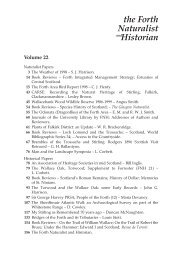fnh journal vol 24 - Forth Naturalist and Historian - University of Stirling
fnh journal vol 24 - Forth Naturalist and Historian - University of Stirling
fnh journal vol 24 - Forth Naturalist and Historian - University of Stirling
You also want an ePaper? Increase the reach of your titles
YUMPU automatically turns print PDFs into web optimized ePapers that Google loves.
4 R. Tipping, R. Waldron, D.C. Cowley<br />
is assumed that this pollen originates from one or all <strong>of</strong> three coniferous<br />
plantations within 2 km <strong>of</strong> the site. The largest <strong>of</strong> these was planted between<br />
1948 <strong>and</strong> 1954, <strong>and</strong>, allowing 15 years for abundant pollen production, the<br />
appearance <strong>of</strong> spruce at 6 cm is assigned a tentative age <strong>of</strong> AD 1965. Ages prior<br />
to this in the core are extrapolated on a linear peat accumulation rate <strong>of</strong><br />
5 yr cm –1 or 0.2 cm yr –1 . The basal sample at 52 cm is given an age <strong>of</strong> AD 1725.<br />
Dates quoted in the following sections are rounded to the decade <strong>and</strong> should<br />
be treated as indicative rather than absolute.<br />
Interpretation <strong>and</strong> Discussion<br />
From the earliest times depicted in the pollen diagram, the l<strong>and</strong>scape<br />
around Ashentrool was being exploited for agriculture. Between about 1725<br />
(52 cm) <strong>and</strong> 1800 (36 cm) there are very high percentages <strong>of</strong> cereal pollen <strong>and</strong>,<br />
although light microscopy cannot distinguish between oats (Avena) <strong>and</strong> wheat<br />
(Triticum), it is very likely that in this upl<strong>and</strong> setting the pollen record<br />
represents oats. Cereal pollen grains do not disperse far, <strong>and</strong> the values<br />
recorded here in excess <strong>of</strong> 15 % total l<strong>and</strong> pollen represent a substantial area<br />
given over to crops, almost certainly from the cultivated ground adjacent to the<br />
peat deposit (Figure 1). Associated weed taxa from the fields may include<br />
species <strong>of</strong> fat hen (Chenopodiaceae) <strong>and</strong> the daisy family (Compositae). It is<br />
interesting that this area <strong>of</strong> well-drained soils, at over 300 m OD, was being<br />
cultivated throughout the 18th century, <strong>and</strong> comparable patterns have been<br />
identified in Southern Scotl<strong>and</strong> (Tipping, 1998). This arable capability <strong>of</strong> the<br />
upl<strong>and</strong>s <strong>of</strong> Scotl<strong>and</strong> supports the view that the widespread change from arable<br />
to pastoral l<strong>and</strong>use that occurred during the 18th <strong>and</strong> 19th centuries was<br />
driven by economic, social <strong>and</strong> technological changes, rather than caused by<br />
repeated crop failure through climate-induced stresses during the ‘little ice age’<br />
(Parry, 1978).<br />
Grazing was also a significant l<strong>and</strong>use in the 18th century. Proportions <strong>of</strong><br />
wild grass pollen (Gramineae



